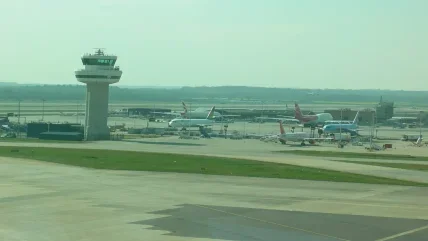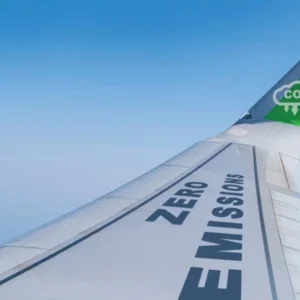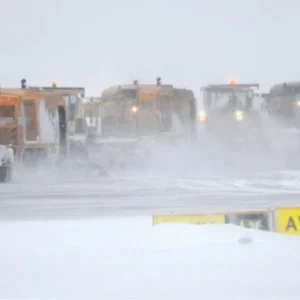
An airport security officer noted something odd on his way home and reported a possible security risk to the Gatwick Airport control centre. In response, on 19 December 2018, all air traffic ground to a halt at Gatwick and would remain that way for almost two days while a search party investigated.
Its quarry was not a bomb threat, but something much more mundane – the security officer had sighted two drones, one hovering above a vehicle inside the airport, the other flying around the perimeter fence.
Initially, 20 police and airport security vehicles drove around the airport, leading to another half dozen unconfirmed drone sightings, and gradually more and more resources were drawn in. On the second day, a police helicopter and several police drones scanned the air, looking for the intruder, to no avail, and by that night the military had arrived with an anti-drone system designed for battlefield use.
After the military system failed to pick up anything unusual, and suitable procedures and safety assurances had been put in place, Gatwick was given the go-ahead to reopen on the morning of 21 December, after having been closed for over 33 hours. Industry experts at the time estimated that airlines had lost around £50m during the disruption, with 1,000 flights cancelled and 140,000 passengers left on the ground.
While this wasn’t the first case of an airport being forced to ground its flights after an unwanted incursion by a drone, real or imagined – Gatwick had experienced previous incidents with drones in July 2017 – the disruption caused has rarely been so severe. The coverage of the Gatwick incident only increased the longer it went on, and it became the public’s main reference point when thinking about the relationship of drones and airports.
Of course, while drones can present a threat when they enter prohibited airspaces, most of those instances aren’t borne out through any desire to cause trouble. That’s the greatest issue facing airspace regulators and airports in this area – the danger isn’t from bad actors, but from general ignorance and the increasing availability of privately owned drones.
As of January 2021, there were 1,782,479 drones registered in the US alone – 1,256,336 for recreational purposes, while the remaining 522,645 were for commercial operation. These drone users, then, are the ones that airports most often have to deal with.
“We call it the three C’s – the clueless, careless and the criminal,” explains Oleg Vornik, CEO at DroneShield, an anti-drone technology developer. “The issue from the airport’s point of view is that all three are equally threatening, whether it’s a drone flown by a child or by a plane watcher.”
Aircraft are at their most vulnerable during landing and take-off, and drones present number of threats during these moments, whether it’s the danger of distracting pilots or the damage that a lithium battery could cause if punctured when a drone is flown into an aircraft’s engine.
“Gatwick was a very, very worrying test case, in that it demonstrated how unprepared we are as an industry,” says Steve Wright, senior research fellow for the Engineering Design and Mathematics department at University of the West of England. Much of the safety legislation around airspaces in the UK was built around the idea that aircraft should not be forcibly brought down to ground under any circumstances – a reasonable concept when dealing with manned aircraft, at least. The default reaction to an incursion, then, has been to close the airstrip until the sky is clear. That’s been a viable system in the past, but as Gatwick demonstrated, bigger airports can’t allow their operations to be halted for minutes, let alone days.
Drone detected
However, any anti-drone countermeasures can only work if a drone is indeed present and can be tracked down. Reality isn’t always so simple, though. A drone doesn’t have to be physically present within an airspace to cause disruption – the operator just needs to think that one might be.
“We need a way to provide airspace awareness,” says Vornik. “A lot of people are fixated on the defeat of the drone, but in a large perimeter facility like an airport, you need a reliable way to detect a dinner-plate- sized white object flying against white clouds.”
One of the key issues facing airports is that their legacy sensor systems, used to identify birds or debris on the runway, are completely inefficient at detecting intruding drones. DroneShield and Dedrone both offer a range of sensor equipment for use in airports, combining a couple of different systems.
Today, there are four principal ways to detect the presence of a drone. The first is radio frequency (RF), which is used to target the communication happening between the drone and the remote control. This is the cornerstone of any counter-drone system due to it being both highly accurate and also passive, which is of the utmost importance for an airfield.
Anti-drone sensors often use video cameras in a secondary role, allowing for a visual payload inspection of a drone. Optical sensors typically need to be directed by other sensors, so they know exactly where to look. This is usually done by either RF or radar, though the latter can have issues identifying specific objects – if radar is set to search for drone-sized targets, there’s a good chance it will turn up every bird or plastic bag in the target area.
The final type of sensor commonly used in anti-drone technology is acoustic, which is used to sense the presence of the rotor speeds, for example. However, this type of sensor isn’t very effective in an airport setting due to its low range and often presents a lot of false positives.
“So no sensor is perfect,” explains Amit Samani, vice-president of sales (Americas & UK) for Dedrone, another anti-drone technology company. “Most organisations today are starting with RF because it’s cost-effective, it’s passive and is low on false alarms. And over time, they’re going to be adding additional sensors as the threat evolves and grows bigger.”
At the same time, governing bodies are looking to make identifying drones easier for airport operators through remote identification. Drones will need to provide certain information that can be received by other parties, similar to registering a mobile phone for a wireless network. That’s not to say, however, that it will solve all the problems facing airport operators.
“It’s not going to solve the bad actors because it’s going to be fairly easy to bypass,” says Samani. “It’s also not going to be backwardly compatible with some of the drones already in the market, [of] which there are many, many millions.”
What remote ID is good for, he explains, is to allow security professionals to “distinguish between the good and the bad”. If five drones are seen operating in a restricted airspace, but four have their remote ID active, then it’s only that final drone that is the real cause for concern – the others can simply be tracked down and asked to take their drone out of the area.
In the US, the FAA have given drone manufacturers 18 months from 21 April 2021 to integrate remote ID into their drones, and 30 or 36 months for operators to ensure that their drones are compliant. Similar laws are under discussion in the UK and EU.
18
Months from 21 April 2021 that the FAA has given drone manufacturers to integrate remote ID into their drones.
FAA
Practical countermeasures
Once a drone has been identified, then, what is the best way to remove it from an airspace? A number of technologies have sprung up to answer that question, but many offer questionable efficiency. “When you have an early market, what you typically find is that lots of people go in and talk about all these cool science fiction type scenarios, but most of them aren’t very practical,” says Samani.
The first is fairly straightforward – what Wright refers to as a “ground-based kinetic countermeasure” in the form of an anti-drone net launcher, or indeed, of more traditional firearms. For obvious reasons, though, taking a drone down with a shotgun in the way you’d do with a clay pigeon might not appeal to commercial airport operators. The range with net launchers is typically also quite limited and made more difficult still if the drone refuses to cooperate by hovering in place.
Alternatively, anti-drone technology can focus on electronic countermeasures, which are far more versatile. Firstly, they try and interfere with the communication between the drone controller and the vehicle itself. In many cases, when the ground-to-air link is disrupted, the drone will break off and do what Wright refers to as a “RTH” – or “return-to-home”. It’s a simple case, then, for airport security to track the drone as it returns to its owner and catch the offending operator.
Another option is to attack the drone with an electromagnetic pulse, which damages the electronics within a drone and can lead to the affected drones dropping straight from the sky. The most desirable and also the most challenging, however, is a cyberattack on the drone itself. This typically involves attempting to spoof the ground station and take direct control of the drone itself, and steer it into a safe zone where it can be retrieved.
For Samani and Vornik, electronic countermeasures offer the best results. If necessary, both Vornik and Samani will use a jamming solution, which neutralises the drone by severing the connection between the drone and the controller or the drone and the satellite. Both of their companies are also able to estimate the location of the drone pilot, which is a more useful countermeasure, in Vornik’s opinion, because it allows security forces to apprehend the pilot directly. After all, in the case of a bad actor trying to deliberately disrupt an airport’s operations, there’s nothing to prevent them from coming back with another drone the next day.
However, using jamming technology in an airport setting does present some challenges. “A drone has to communicate with its remote control,” Samani explains. “And the way that it does is it uses unrestricted frequencies, such as 2.4GHz or 5.8GHz. Now, when I jam the signal of that drone, I’m potentially impacting other systems on the airfield.”
This can affect landing gear and radar, which often rely on the same frequencies that jammers use, though precautions are taken to minimise the risk. For this reason, using jamming technology in an airspace requires gaining high levels of permission from government bodies, due to the potential collateral damage. For smaller airports, with lower traffic levels, it is often easier to expand their operating procedures to prepare for potential drone disruption and temporarily halting flights during an incursion.
Start at the beginning
As the Gatwick incident demonstrated, technology can only go so far – at some point, a human being will have to make a decision as to whether or not the threat has been dealt with or if it was never there in the first place. “You’ll need to be really confident in your solution to be able to say, ‘It’s not showing up, so it’s definitely not there’,” says Paul Diestelkamp, head of business development & solutions at Air Navigation Solutions, who experienced the Gatwick incident on the ground at the time, serving as the air navigation services provider. In his opinion, the most important thing is for airports to ensure that they have robust procedures and communications established for dealing with these situations.
“People tend to realise that action needs to be taken and suggest ‘Let’s buy some technology’,” he says. “The purchase and cost of equipment is a clear demonstration of action taken that can be used as assurance for the board and other stakeholders to generate the impression [that] the risk is mitigated.”
That’s not to say that he believes technology doesn’t have an important role to play, of course, but more that he sees it as “sort of the end of the stick and not the beginning of the process”. For Diestelkamp, rather than focusing on technology to try and keep drones out of airport operations, it would be more beneficial to create measures that make it easier for the public to make their drones known to airspace monitors.
“If you want to be able to protect yourself in the longer term, you need to accept that drones are going to be there and you need to integrate them,” he says. Implementing systems that can provide drone users with information regarding how near they are to restricted airspace, and that can alert them if they cross that threshold, would be of huge benefit. So would a system that requires users to opt-in to before they take their drone out, so that they are logged into the relevant systems in nearby airspaces and can be identified without airports having to invest in the sensor technology to do it themselves.
Ultimately, drones are here stay, and as they become increasingly inexpensive and more accessible to the general public, the need for airports to protect their airspaces – however they choose to do so – will only continue to grow. The danger of another Gatwick occurring will remain ever-present and require constant vigilance from operators, or the next incident could be even more serious.






